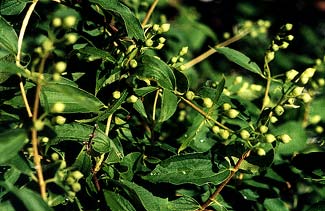
Western Syringa:
Meriweather Lewis's
Wild Mock Orange
I am the white syringa, falling now,
When some one shakes the bough.
What matter if I lose my life's brief noon?
You laugh, "A snow in June!"
-Margaret Gilman George-Davidson
(1869-1896)
(1869-1896)
How'd Philadelphus lewisii get the common name "Syringa," which is the scientific name of lilacs? Beats me. Its other common name is Mock Orange (or Meriweather Lewis's Mock Orange). It doesn't even get that name to itself, as Choisya ternata is called Mock Orange as well. 'Round these parts where it grows wild it is usually just called Syringa without reference to lilacs, though this does indeed lead to occasional confusion.
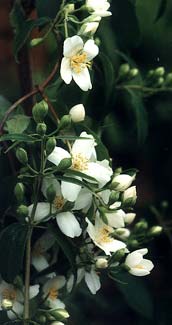 Since 1931, this shrub has been the state flower of Idaho, where Granny Artemis is from. It's actually the first state flower for any state, because long before it was officially acknowledged by Idaho's state Senate, it was already incorporated into the state seal (in 1890), & was used as the symbol of Idaho at the 1893 World's Fair held in Chicago. And one does see them in great numbers along many an Idaho highway, especially throughout the northern parts of the state.
Since 1931, this shrub has been the state flower of Idaho, where Granny Artemis is from. It's actually the first state flower for any state, because long before it was officially acknowledged by Idaho's state Senate, it was already incorporated into the state seal (in 1890), & was used as the symbol of Idaho at the 1893 World's Fair held in Chicago. And one does see them in great numbers along many an Idaho highway, especially throughout the northern parts of the state.It grows throughout western North America, having a few distinct races & cultivars of its one species. If we ever add another one to our gardens, it will likely be the "double flower" variety. But the one we have is a local wild subspecies which is native to the Olympic Penninsula, P. l. gordianus, sometimes designated Coastal Mock Orange.
"Gordianus" names it after Emperor Marcus Antonius Gordianus (Gordien III of Rome), while the genus name Phildelphus refers to Ptolemy II Philadelphus of Egypt. Quite impressive for such an unpretentious shrub! "Lewisii" of course alludes to the first white man to describe it. Meriweather Lewis jotted down discriptions of specimens in Nez Perce territory on May 6, 1806, & again in Blackfoot territory on July 4.
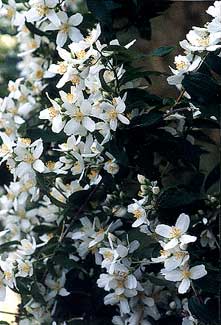 The Gordianus subspecies gets taller & remains narrower than the usual western syringa, with a much more upright habit & fewer of the limbs fountaining, though when in heavy flower it certainly does weight those upright limbs down. Ours grows straight up to the eaves of the house, & though it is as tall as the Abelia & the Forsythia also along that side of the house, it is never so sprawlingly in the way of the path as are those other two huge shrubs.
The Gordianus subspecies gets taller & remains narrower than the usual western syringa, with a much more upright habit & fewer of the limbs fountaining, though when in heavy flower it certainly does weight those upright limbs down. Ours grows straight up to the eaves of the house, & though it is as tall as the Abelia & the Forsythia also along that side of the house, it is never so sprawlingly in the way of the path as are those other two huge shrubs.It blooms on two-year-old or older stems, & does so quite extravagantly in June & early July, white four-petalled blossoms with yellow interior. The blooms are extremely fragrant, with an appearance & perfume that explains why it's called "Mock Orange." It demands no great care to flourish, not even needing to be watered; normal rainfall meets its needs.
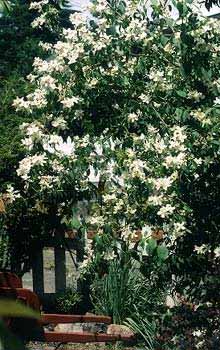 The first photo at the top of the page shows how this deciduous shrub looks in early to mid-June when it gets thick all over with green buds. The second photo exactly at mid-June shows it half in bud & half flowers. By the third week in June the flowers become dense along all the limbs. The third photo is from very early in July, & the fourth photo also in July gives an idea of its large size. A final tiny photo at the bottom shows the appearance of post-bloom in late July, when the sepals linger on the branches looking like small pale green flowers well into August.
The first photo at the top of the page shows how this deciduous shrub looks in early to mid-June when it gets thick all over with green buds. The second photo exactly at mid-June shows it half in bud & half flowers. By the third week in June the flowers become dense along all the limbs. The third photo is from very early in July, & the fourth photo also in July gives an idea of its large size. A final tiny photo at the bottom shows the appearance of post-bloom in late July, when the sepals linger on the branches looking like small pale green flowers well into August.It is growing by our back porch, where the scent of it is intoxicating as we come & go by that door. On its perfumiest days it is a bit overwhelming & with better planning would not have been immediately beside the door. It attracts huge numbers of pollinators, predominantly bees.
It should at fairly long intervals have as much as a fourth of the older branches cut to the ground in order to "freshen" & open it up to keep it in maximum bloom, taking care not to get the equally tall young branches, which have a smoother greener appearance so are easy to tell from the older greyer limbs that have rough bark. First-year leaves on first-year branches can look so different from the older parts of the plant it sometimes looks like two distinct shrubs have gotten entwined.
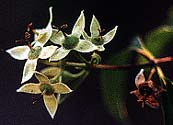 Pruning needn't be every year. Every third year would be a lot, though the small twiggy bits that can accumulate & clutter the appearance at the bottom of the shrub should be removed more often, in order to maintain the vase-shape &, in our case, to open up the ground to plant crane's-bills or heucheras & bulbs under the syringa.
Pruning needn't be every year. Every third year would be a lot, though the small twiggy bits that can accumulate & clutter the appearance at the bottom of the shrub should be removed more often, in order to maintain the vase-shape &, in our case, to open up the ground to plant crane's-bills or heucheras & bulbs under the syringa.The old wood of the long straight stems can be surprisingly hard. Northwest native peoples used it to make combs, bows, arrows, & fishing spears. The First Peoples also used syringa for shampooing their hair. If rubbed furiously in water, the leaves & flowers create a sweet-smelling froth, much like soap. Ah! Those sweet-smelling First Peoples!